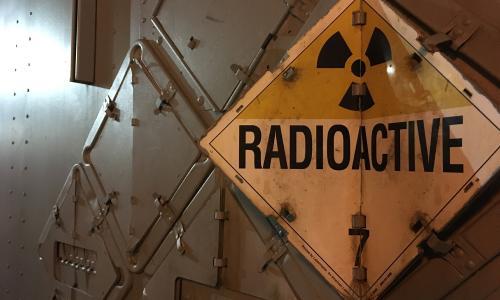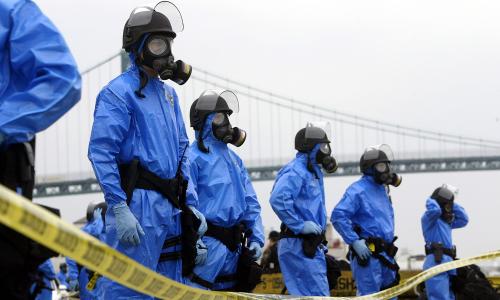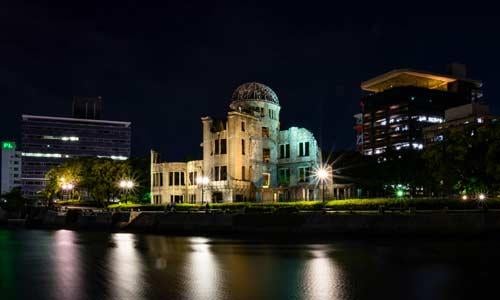Radiation is associated with a wide range of adverse health outcomes, including acute radiation sickness, burns, cancer, cardiovascular disease, or even death.
Chronic health disorders associated with exposure to radioactive materials can affect the heart, lungs, thyroid, brain, and immune system, and can also include blood disorders, cataracts, malignant tumors, and keloids. Ionizing radiation can also affect human health through genetic alterations that can result in cancer, organ dysfunction, and immune and metabolic disorders.
| Disorder | Dose | Description | Source Links |
|---|---|---|---|
| Acute radiation syndrome (ARS) | 70 rads or 0.7 Gy, mild symptoms may be observed as low as 0.3 Gy or 30 rads | All or most of the body is exposed to radiation; symptoms include nausea, vomiting, headache, and diarrhea within hours after exposure, and can even cause death in the following days or weeks | CDC |
| Cancer (general) | 100 millisieverts (mSV) or 0.1 Gy | Includes multiple myeloma, non-Hodgkin lymphoma, thyroid cancer, lung cancer, and other mostly rare cancers | WHO |
| Cardiovascular disease | 0.5 Gy + | Heart disease, especially ischemic heart disease, and cerebrovascular disorders | NIH |
| Cutaneous radiation injury (CRI) | 2 grays (Gy) or 200 rads2 + | Injury to the skin, usually due to direct contact with radioactive material | CDC |
| Thyroid disease | 5 Gy to 70 Gy | Encompassing term for all conditions affecting normal function of the thyroid, including radiation-induced thyroid disease | NIH |
Acute exposure to radiation (as in direct contact with radioactive material or being near a nuclear detonation) can result in cutaneous radiation injury (CRI), a skin burn that can occur at radiation doses as low as 2 grays (Gy) or 200 rads2, increasing in severity as the dose increases. At the site of a nuclear detonation, humans are incinerated; people farther away can receive skin burns. For people not close enough to be burned (1,500 meters or more away), their internal organs will receive a large dose of gamma rays and neutrons, causing long-term harm.
Acute radiation syndrome (ARS) can also occur after a high-dose, sudden exposure, when the radiation can penetrate to internal organs and all or most of the body is exposed. This is also commonly referred to as “radiation sickness.” Symptoms include nausea, vomiting, headache, and diarrhea within hours after exposure, and may cause death in the following days or weeks. The dose range for radiation sickness is 70 rads or 0.7 Gy, and mild symptoms may be observed at doses as low as 0.3 Gy or 30 rads. There are known acute effects to the brain, thyroid, blood, heart, gastrointestinal tract, reproductive system, and even hair at doses of 200 rem and higher.
| Dose (rem) | Effects |
|---|---|
| 5-20 | Possible late effects; possible chromosomal damage |
| 20-100 | Temporary reduction in white blood cells |
| 100-200 | Mild radiation sickness within a few hours: vomiting, diarrhea, fatigue, reduction in resistance to infection |
| 200-300 | Serious radiation sickness effects as in 100-200 rem and hemorrhage; exposure is a Lethal Dose to 10-35% of the population after 30 days (LD 10-35/30) |
| 300-400 | Serious radiation sickness; also marrow and intestine destruction; LD 50-70/30 |
| 400-1000 | Acute illness, early death; LD 60-95/30 |
| 1000-5000 | Acute illness, early death in days; LD 100/10 |
Radiation and cancer
Cancers and genetic alterations can occur from both chronic and acute exposures to radiation. Multiple myeloma, non-Hodgkin lymphoma, thyroid cancer, lung cancer, and rare cancers of the stomach and other organs have been seen among people exposed to radioactive materials.
The World Health Organization notes that the atomic bombings showed significant increases in cancer risk among people who received doses above 100 millisieverts (mSv). However, low-dose, chronic exposures over long periods of time may also result in cancer. If the time between exposure and disease development (lag time) is too long, it becomes statistically harder to prove whether the cause is radiation exposure and not lifetime exposures to other chemicals and pollution.
One of the most common radioisotopes associated with nuclear weapons testing and use is iodine-131, which strongly targets the thyroid gland. Thyroid cancer is a rare disease across the United States, with a lifetime estimated risk of just 1.2 percent, but because it is easy to miss unless screening for it specifically, it is usually diagnosed at a later stage. Women and children have a higher risk of radiation-induced thyroid cancer because their thyroids absorb radiation more readily than their male or adult counterparts.
Other chronic diseases associated with radiation exposure
Other chronic health disorders besides cancer can be induced by radiation exposure: heart disease, neurological disorders, autoimmune disorders, and thyroid disease warrant concern. Indeed, the link between exposure and cerebrovascular disease and ischemic heart disease has led cardiologists at the American Heart Association to call for an end to the US nuclear weapons program (We share this letter to highlight medical experts engaging in nuclear policy. This may not represent all members of the American Heart Association’s opinions on the topic, and no one from the American Heart Association reviewed this webpage).
In a meta-analysis (a statistically rigorous systematic review comparing published statistics) on heart disease and ionizing radiation, researchers found ischemic heart and cerebrovascular disease are strongly associated with radiation even at low dose rates of 0.5 Gy/hour. Among a US population living with ischemic heart or cerebrovascular disease, those exposed to ionizing radiation had a 14 percent higher risk of death compared with people not exposed to ionizing radiation. In a study of Japanese atomic bomb survivors, cardiovascular disease was increased, especially for those exposed to this radiation early in life.
Understanding social determinants of health and health disparities
Some communities are more burdened by radioactive materials than others, including Indigenous communities, bombing and testing survivors, atomic workers and veterans, and low-income communities. In some of these communities, the effects of radiation are worsened by the oppressive systems associated with social determinants of health (SDOH), which are often socially constructed factors such as gender, race, ethnicity, age, and socioeconomic status. These same historically hateful systems are also the very ones that invented race, ethnicity, a gender binary, capitalist greed, and more. These systems and institutions grounded in hate can each—and in combination—compound the harms of radiation exposure. Due to systemic oppression including xenophobia, racism, and ageism, specific identity groups may lack access to quality health care or living assistance, nourishing and affordable food, and a lack of public health interventions and education. These systemic differences in care, funding, and access can result in health disparities—population-wide, statistically significant alterations to health outcomes (often for the worse) and environmental exposure doses (often higher dosing).
Nuclear regulatory science, by not historically adjusting its data for gender or age and not considering the effects of sexism, ageism, nuclear colonialism, and systemic oppression on health outcomes, has done women, children, and other vulnerable groups a disservice. You can learn more about nuclear frontline communities here.
The US government’s role in radiation harms
Much of what we know about the toxicants released by nuclear detonations comes from nuclear weapons testing. Sadly, frontline communities were not informed of the risks of weapons tests in a timely nor complete way, and often not at all.
In a recent report, it was revealed that Manhattan Project Chief Medical Officer Stafford Warren issued a top-secret report in the days after the world’s first nuclear weapons test, the 1945 Trinity test in New Mexico, showing the extent of the radioactive fallout. Warren stated that, “The dust outfall from the various portions of the [nuclear mushroom] cloud was potentially a very serious hazard over a band almost 30 miles wide extending almost 90 miles northeast of the site.” Warren further reported that a few days later there was still “a tremendous amount of radioactive dust floating in the air.”
However, General Leslie Groves, the director of the Manhattan Project, told an advisor that reports of radiation sickness were "propaganda" from Japan. Later, when Groves couldn't deny that there were deaths from radiation sickness, he continued to mislead the public and US Congress, stating that radiation sickness was "a very pleasant way to die." Disinformation like this continued to be shared by Groves and others in power.
Much of what is known about the harms to community health has come from frontline communities themselves, who have advocated for government transparency and research to understand their risks. There are many examples of communities coming together to highlight the harms of radioactive materials, such as the Navajo Nation, Hanford Site “Downwinders” and plaintiffs, and families exposed to Manhattan Project-era waste in St. Louis, Missouri. Many of the laws and safety or regulatory changes created around nuclear harm also involved activists highlighting the evidence and pushing policymakers to compensate harmed communities.
Efforts to compensate victims
The US government currently has three different programs to assist US citizens affected by the nuclear weapons life cycle: the Energy Employees Occupational Illness Compensation Program Act (EEOICPA), the Radiation Exposure Compensation Act (RECA), and Veterans Affairs Compensation. In addition, the Compact of Free Association (COFA) is an international agreement between the United States and three Pacific island nations exposed to harms from the US nuclear weapons program.
Many of these programs are flawed, hard to navigate, and still exclude those who are experiencing harm. Lilly Adams, senior outreach coordinator with the Union of Concerned Scientists, refers to them as “a patchwork approach with gaping holes.”
The Energy Employees Occupational Illness Compensation Program Act focuses on compensating atomic workers who are injured or become ill while working. It offers higher levels of compensation than the other programs and includes back and future payments for health outcomes.
Some claims are evaluated using dose reconstruction, which attempts to calculate a worker’s specific exposure level based on the radiation badges that some workers carried while on the job. However, this can prove to be a high barrier for some eligible claimants, since there were many flaws with data collection during nuclear production, and dose reconstruction involves a lot of uncertainty since it is often done retrospectively. Most workers are instead included under a presumptive structure, where it is assumed that it is “more likely than not” that a specific radiogenic illness in a worker from a specific site was caused by radiation or toxic exposure in the workplace.
The Radiation Exposure Compensation Act provides one-time compensation to some community members affected by nuclear testing, uranium mining, and veterans exposed during their service, and includes an apology to Nevada test site Downwinders. This is significant because official US statements of remorse are often sought by harmed communities as a start to making amends, and there are many communities that have not received an apology in other pieces of legislation. Established in 1990, the program is frequently at risk of expiring; is limited to specific geographic regions, mining occupations, and disorders; and does not provide any medical care.
Veterans Affairs Compensation is based on how much a veteran’s service contributed to their exposure. It provides monthly payments to service members who were exposed to radioactive materials while being held as a prisoner of war in Japan, participating in aboveground testing, cleaning up radioactive waste, or participating in activities at sites covered under the EEOICPA.
Each compensation program is managed by a different agency and there is little communication across agencies, often resulting in restitution being unjustly delayed or denied.
Radiation Exposure Compensation Act (RECA)
Establishment year and Administering agency
- Established 1990
- Department of Justice
Who is covered?
- Nevada Test Site Downwinders
- Uranium workers
- Some atomic veterans
What benefits does the program offer?
- One-time compensation of $50k-$150k
- Cancer screenings
- Apology to victims
How is eligible exposure determined?
- 100% presumptive
Scope (as of April 2024)
- 41,500 claimants
- $2.6 billion awarded
Energy Employees Occupational Illness Compensation Program Act (EEOICPA)
Establishment year and administering agency
- Established 2000
- Departments of Labor and Energy
Who is covered?
- Workers from nuclear production sites
What benefits does the program offer?
- One-time compensation of $150k-$250k
- Pays medical expenses and other benefits
How is eligible exposure determined?
- Normally requires dose reconstruction
- "Special Exposure Cohorts" are presumptive
Scope (as of April 2024)
- 140,000 claimants
- $26 billion in compensation + medical bills
Veterans Affairs Compensation
Establishment year and administering agency
- Established 1984
- Department of Veterans Affairs
Who is covered?
- Veterans exposed during service
What benefits does the program offer?
- Monthly payments based on illness
- Medical and other benefits
How is eligible exposure determined?
- Mix of dose reconstruction and presumptive
Scope (as of April 2024)
- Unable to find—might have to request from VA
Notably, communities that may have been exposed to radiation and other toxic emissions from nuclear waste sites or nuclear production sites are not covered under any of these programs, including the family members and spouses of atomic workers.
There are international efforts to create support for frontline communities using the 2021 Treaty on the Prohibition of Nuclear Weapons (TPNW), often referred to as the Nuclear Ban Treaty. This treaty outlines an international fund that could provide restitution to nations around the globe affected by nuclear materials exposure that would assist them in treating their people and attempting to remediate leftover nuclear waste. However, none of the nations that possess nuclear weapons—including the United States—have joined the treaty. The United States has even boycotted treaty efforts at the United Nations and sent letters to allied nations warning them not to join the treaty.
Related explainers

Understanding Radiation

How Radiation Interacts with the Human Body

Where Radiation Comes From

The Language of Radiation: A Glossary
The Union of Concerned Scientists has worked on nuclear weapons-related issues for more than 50 years. Get involved here.




